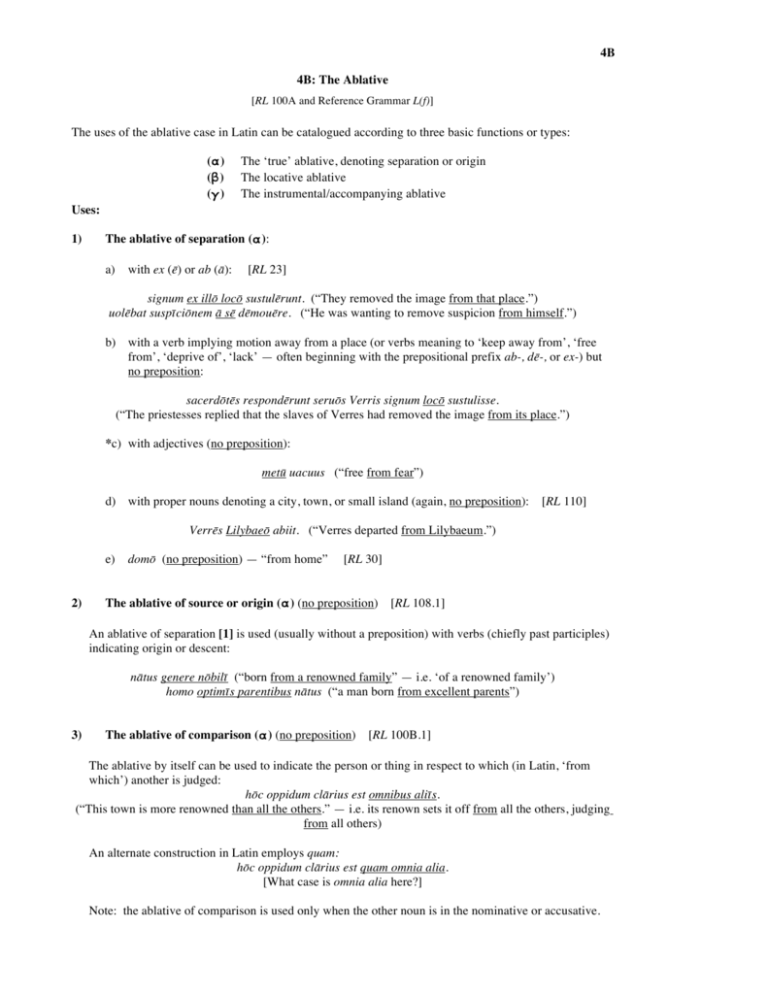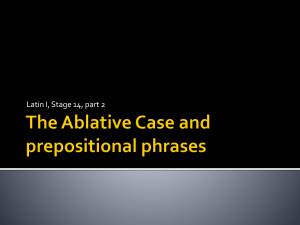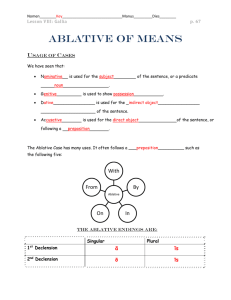The Ablative
advertisement

4B 4B: The Ablative [RL 100A and Reference Grammar L(f)] The uses of the ablative case in Latin can be catalogued according to three basic functions or types: (a) (b) (g) The ‘true’ ablative, denoting separation or origin The locative ablative The instrumental/accompanying ablative Uses: 1) The ablative of separation (a): a) with ex (ē) or ab (ā): [RL 23] signum ex illō locō sustulērunt. (“They removed the image from that place.”) uolēbat suspīciōnem ā sē dēmouēre. (“He was wanting to remove suspicion from himself.”) b) with a verb implying motion away from a place (or verbs meaning to ‘keep away from’, ‘free from’, ‘deprive of’, ‘lack’ — often beginning with the prepositional prefix ab-, dē-, or ex-) but no preposition: sacerdōtēs respondērunt seruōs Verris signum locō sustulisse. (“The priestesses replied that the slaves of Verres had removed the image from its place.”) *c) with adjectives (no preposition): metū uacuus (“free from fear”) d) with proper nouns denoting a city, town, or small island (again, no preposition): [RL 110] Verrēs Lilybaeō abiit. (“Verres departed from Lilybaeum.”) e) 2) domō (no preposition) — “from home” [RL 30] The ablative of source or origin (a) (no preposition) [RL 108.1] An ablative of separation [1] is used (usually without a preposition) with verbs (chiefly past participles) indicating origin or descent: nātus genere nōbilī (“born from a renowned family” — i.e. ‘of a renowned family’) homo optimīs parentibus nātus (“a man born from excellent parents”) 3) The ablative of comparison (a) (no preposition) [RL 100B.1] The ablative by itself can be used to indicate the person or thing in respect to which (in Latin, ‘from which’) another is judged: hōc oppidum clārius est omnibus aliīs. (“This town is more renowned than all the others.” — i.e. its renown sets it off from all the others, judging from all others) An alternate construction in Latin employs quam: hōc oppidum clārius est quam omnia alia. [What case is omnia alia here?] Note: the ablative of comparison is used only when the other noun is in the nominative or accusative. 4B 4) The locative ablative (b): Used to indicate place: 5) a) with in [RL 10] b) in connection with the locative construction (see grammar sheet) The ablative of time (b) (no preposition) [RL 110] [RL 67] A particular use of the locative ablative [4], used to indicate the specific time when or within which an action occurs: tū hōc tempore senex miserrimus es. (“At this time you are a most wretched old man.”) seruī Verris signum nocte sustulērunt. (“The slaves of Verres removed the image at night.”) Satūrnī stella trīgintā ferē annīs cursum suum conficit. (“The planet Saturn completes its period in about thirty years.”) Contrast the accusative of extent of time: Diodōrus Rōmae multōs annōs habitābat. (“Diodorus was living at Rome for many years.”) 6) The ablative of instrument or means (g) (no preposition) [RL 84] The ablative alone can be used to indicate the instrument with which (or by means of which) an action is performed: pugnīs mē uerberat. (“He/She is hitting me with his/her fists.”) pedibus hūc uēnit. (“He/She came here by foot.”) 7) The ablative of price (g) (no preposition) A specific instance of the ablative of instrument or means, used to indicate the resources (monetary or other) employed in a purchase: multō aurō hanc aulam ēmī. (“I bought this pot at the cost of much gold.”) Contrast the genitive of value. 8) The ablative of measure of difference (g) (no preposition) [RL 100B.5] The ablative can be used to indicate the degree by which one thing differs from another: Verrēs multō turpior est quam comitēs suī. (“Verres is more base by far than are his companions.”) multō mē doctior (“far more learned than I”) paulō ante (“a little earlier”) Note the potential confusion here with the ablative of comparison [3]. 4B 9) The ablative with certain deponent verbs (g) (no preposition) [RL 100B.4] An instrumental ablative is used with utor, fruor, potior, fungor, uescor, and their compounds: hīs uerbīs ūsī sunt. (“They employed these words.”) mālunt ōtiō et pāce fruī. (“They prefer to enjoy leisure and peace.”) 10) The ablative of cause (g) (no preposition) [RL 108.2] Related to [6], this ablative indicates the underlying cause of an action: timōre hōc fēcit. (“He/She did this by reason of fear.”) Verrēs hominem argentī cupiditāte accusāuit. (“Verres accused the man by reason of his greed for money.”) uīrēs lassitūdine dēficiēbant. (“Their strength was beginning to fail by reason of weariness.”) 11) The ablative of personal agent (g) (with ā / ab) [RL 120 n. 2; 161 n. 2] The ablative is used with passive verbs to indicate personal agent. In this construction the ablative is introduced by ā / ab: nāuis ā Tadiō capta est. (“The ship was captured by Tadius.”) Occasionally this construction is employed with nouns that designate a thing rather than a person: in such a case, the thing so indicated is personified. Conversely, a human agent can be indicated by the ablative without ā / ab, but in such a case the human agent is ‘de-personalized’, as it were, being presented as a mere instrument (cf. 6). 12) The ablative of accompaniment (g) (with cum) [RL 2A] The ablative with cum is used with verbs of motion to denote “in company with” (usually, but not invariably, in reference to a person): cum fratre meō uēnī. (“I have come with my brother.”) cum tēlō uēnit. (“He/She came with a weapon.”) Note: 1) be sure to distinguish this ablative from the ablative of instrument or means: uēnit cum tēlō means “He came, and brought a weapon with him.” A Roman would never say, e.g., “Brūtus necāuit Caesārem cum tēlō” to indicate that Brutus killed Caesar ‘with a weapon.’ 2) instead of cum tē, cum mē, cum uōbīs, cum nōbīs, the Romans used tēcum, mēcum, uōbīscum, nōbīscum. 13) The ablative of attendant circumstances (g) (with cum) [RL 100B.2] An extension of the ablative of accompaniment, it is employed to indicate a state of affairs that accompanies or results from a certain action: cum summā reī pūblicae salūte et cum suā peste atque perniciē, Catilīna ad impium bellum profectus est. (“Catiline set out upon an unholy war which resulted in the utmost safety of the state and in his own ruin and destruction.”) 4B 14) The ablative absolute (g) (no preposition) [RL 109] In Latin, a noun (or pronoun) and a participle agreeing with it often are put in the ablative case to indicate the circumstances under which the action indicated by the main verb occurs. This usage represents a variation on the ablative of accompaniment [12]. Like any participial clause, it can be translated in a variety of ways: temporal (“When …”), causal (“Because …”), concessive (“Although …”), conditional (“If …”): hīs rēbus audītīs, coepimus timēre. (“When/After/Since/Because/Although/Even though/If — these things were heard, we began to fear.”) eō imperium tenente, Rōmānōs timeō. (“When/While/Since/Because/Although/Even though/If — he holds absolute power, I fear the Romans.”) Note: 1) The ablative absolute is merely a peculiar variant of the circumstantial participle: it employs an ablative of accompaniment to append a circumstantial participle to a sentence when the subject of the participle does not appear in the main clause. 2) Thus the noun or pronoun of the ablative absolute should not appear in the main sentence. 3) Inasmuch as no present participle of sum exists in Latin, it is often simply to be understood in such constructions: Verre praetōre, omnēs timēbant. (“Verres [being] praetor, all were afraid.” — i.e., “While/Because, Although — Verres was praetor, all were afraid.”) Note the frequent use of the ablative absolute to indicate a specific year by naming the consuls for that year: Metellō et Āfrāniō consulibus … (“When Metellus and Afranius were consuls …”) 15) The ablative of manner (g) [RL 100B.3] The ablative can be used to indicate the manner in which an action is performed. Usually this ablative is introduced by the preposition cum. However, if the noun in the ablative is modified by an adjective, cum regularly is omitted. cum dignitāte morī satius est quam cum ignōminiā uīuere. (“It is better to die with honour than to live in disgrace.”) summā celeritāte peruēnit. (“He/She came with the greatest speed.”) Note that you usually can translate this ablative into English by means of an adverb. (E.g., in the above examples: “It is better to die honorably than to live shamefully.” “He/She came very quickly.”) 16) The ablative of description (g) (no preposition) [RL 49] A noun in the ablative, accompanied by an adjective, can be used to describe the qualities by which a person is characterized: Diodōrus, uir summā grauitāte, maximē īrātus est. (“Diodorus, a man of the utmost dignity, became extremely angry.”) senex cānīs capillīs et ueste sordidā (“a man with white hair and unclean garments”) Note the very similar genitive of description (grammar section 101 in your books). The genitive is used to denote permanent or inherent qualities or precise details regarding number, amount, dimensions, age, or time; the ablative, by contrast, can refer to external or transient qualities (like the garments in the last example above) but is also used, exclusively, to describe parts of the body (like the old man’s hair in the last example above). Often there is little distinction between the two constructions. You might find it easiest to think of the ablative of description as an extension of the ablative of accompaniment: since it denotes things that ‘accompany’ a person, it need not refer to permanent or inherent qualities. 4B 17) The ablative of respect (ablative of specification) (b or g) (no preposition) [RL 147] The ablative is used (particularly in poetry) to specify the respect in which something is true: numquam uictus est uirtūte. (“He was never conquered in respect to courage.”) litterīs Latīnīs docta (“learned in respect to Latin literature”) genere fortūnāta (“lucky in regard to birth”) The supine in –ū is employed exclusively in this construction: mīrābile dīctū (“miraculous in the saying,” “marvelous (even) to say”)








